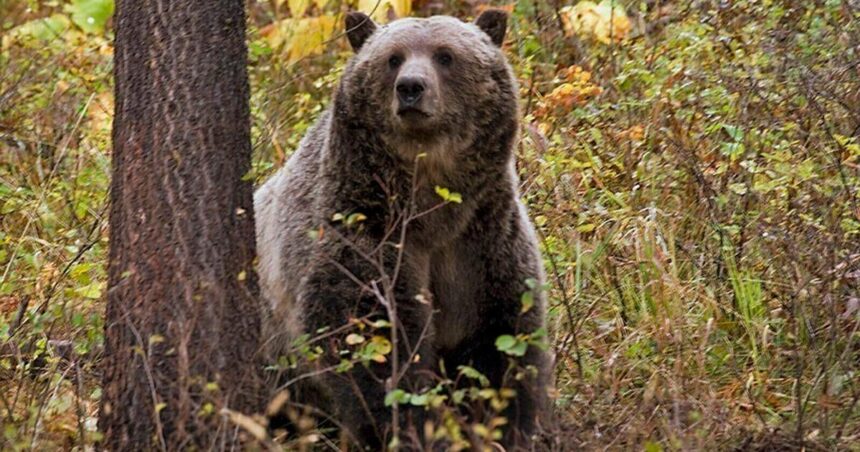The U.S. Forest Service’s method of calculating road density and closing roads in the Flathead National Forest, along with U.S. Fish and Wildlife Service’s analysis of the issue, have been deemed illegal under the Endangered Species Act for a second time because of potential harm to grizzly bears and bull trout.
Nonprofits Swan View Coalition and Friends of the Swan, represented by Earthjustice environmental law firm, sued the Forest Service and Fish and Wildlife Service over the Forest Service’s revised management plan for the Flathead, often called a forest plan, and FWS’ analysis of whether and how components of the plan related to road closures, road density calculations and culvert removal would harm grizzlies and bull trout.
The lawsuit was the second the groups have brought over the issue. The Swan View Coalition, Friends of the Swan and WildEarth Guardians first sued in April 2019 over the revised Flathead plan, which the Forest Service adopted in December 2018. In 2021, U.S. District Judge Don Molloy ruled that the Forest Service and FWS violated the Endangered Species Act by watering down road density and closure standards and culvert removal requirement, and failing to properly analyze or justify the impacts of the changed standards.
People are also reading…
Molloy let the plan remain in place but ordered the agencies to revisit the issues and remedy deficiencies. Swan View Coalition and Friends of the Swan appealed the decision to the Ninth Circuit Court of Appeals. The Ninth Circuit dismissed the appeal in June 2023, ruling the issue moot because FWS had by then released its revised analysis of the issue, as Molloy had ordered.
But the groups believed the revised analysis and Biological Opinion from FWS, which the Forest Service relied upon in its forest plan, held many of the same deficiencies as the original. Swan View Coalition and Friends of the Swan filed the new lawsuit over the revised Biological Opinion in 2022, before their original appeal was dismissed, bringing many of the same issues back anew before a federal judge in Missoula. The latest decision in the matter came as a ruling in that lawsuit.
In a 49-page order signed June 28, U.S. District Court Judge Dana Christensen found that the Forest Service and FWS continued to violate the ESA, even with the revised Biological Opinion ordered in the prior lawsuit.
“The government admits that illegal use of closed roads is a chronic problem, but has twice failed to account for those additional impacts to threatened grizzly bears,” Keith Hammer, chair of Swan View Coalition, wrote in a statement. We are pleased that the court has again sent the agencies back to the drawing board.”
The Forest Service does not comment on litigation.
Density dispute
The underlying issue in the cases was how the Forest Service handles and classifies disused roads on the forest and whether those roads figure into calculations of road density.
Grizzly bears tend to die in or disperse from roaded forests, according to numerous studies collected by the Interagency Grizzly Bear Committee and FWS. Grizzly sow and cub survival generally falls when the density of open roads surpasses 0.64 miles of road per square mile of land. Runoff from road surfaces, particularly when roads go unmaintained, and culverts that allow streams to pass under roads can harm bull trout and degrade their habitat.
Most of the Flathead National Forest — 2.1 million of a total 2.4 million acres — falls within grizzlies’ Primary Conservation Area, or PCA. The Flathead’s portion of the PCA accounts for 37% of the entire Northern Continental Divide Ecosystem PCA for the species, which is listed as threatened under the ESA. The Northern Continental Divide Ecosystem, home to more that 1,000 grizzlies, is one of two successful ecosystems, alongside the Greater Yellowstone, targeted for grizzly recovery under the ESA.
The Flathead also contains “12 bull trout core areas of the Columbia Headwater Recovery Unit and contains designated bull trout critical habitat in four sub-units of the Clark Fork River Basin Critical Habitat Unit,” according to Christensen’s ruling.
The Forest Service amended the Flathead’s original 1986 forest plan in 1995 to specify standards for calculating density of open roads and all roads, open or not, on the forest. Amendment 19 required that open motorized road density not exceed 1 mile of open road per square mile in the PCA for grizzly bears. Total motorized road density was not to exceed 2 miles per square mile in the PCA.
Amendment 19 also set a threshold for when a disused road could be excluded altogether from total road density calculations. A road had to be fully “reclaimed” — that is, “treated in such a manner so as to no longer function as a road or trail and has a legal closure order until reclamation is effective.”
Reclamation, per Amendment 19, required that culverts be removed entirely, the road bed be regraded to match the natural contours of the terrain, natural debris be placed sporadically across the former road, and natural plants grown along the former road. The first 200–600 feet must also “be treated in such a manner so as to preclude its use as a motorized or non-motorized travel way.”
In other words, a road could only be excluded from road density calculations if the full length of the road had been reclaimed to a natural condition and made virtually impossible to use. Reclaimed roads were not considered for reopening or any future use.
The 2018 plan retained the numeric limits on road density but scrapped Amendment 19’s standards for excluding a road from density calculations in favor of what conservation groups argued, and courts have twice agreed, is a less-stringent standard that likely leads to greater-than-allowed road density and usage in practice.
Rather than a road needing to be completely reclaimed to be discounted from density calculations, the revised forest plan stated that a road merely be made “impassible” to be excluded. Impassible roads need only be blocked at the start with a road-closure device and could remain in the forest’s road inventory if the Forest Service intended to use the road again in the future.
And, critical to bull trout, the revised plan did away with the requirement for culvert removal along disused roads.
So, under the new plan, a road need only be closed off, rather than fully reclaimed, to be excluded from road density calculations. But road closures are often ineffective.
A Swan View Coalition survey released in May 2023 found only a 65% efficacy rate for road closures, such as berms or gates, across the Flathead National Forest. A survey by FWS found that road closure efficacy on the Flathead ranged from 90% to 97%, with a forest-wide average of 92%.
However, in a separate recent ESA case against the Forest Service over roads in grizzly habitat, Alliance for the Wild Rockies v. Marten, Forest Service law enforcement records introduced as evidence showed that road closure devices on the Helena-Lewis & Clark National Forest were effective only 43% of the time. And a 2004 survey submitted as evidence in the current Flathead lawsuit found that road closures were only 37.5% effective.
When developing a specific project or revising a forest plan, the Forest Service must consult FWS, the agency that oversees species protected under the ESA, to determine whether, how and to what degree a Forest Service proposal will harm protected species. FWS releases a Biological Opinion outlining its assessment, which the Forest Service then relies on in crafting and justifying its action.
Despite acknowledging a variety of surveys indicating the efficacy, or lack thereof, of road closure devices, and scientific evidence showing how unauthorized road use negatively impacts grizzly bears, FWS nonetheless concluded in its revised Biological Opinion that it was not possible to ascertain how ineffective road closures might impact the species.
Christensen ruled that FWS violated the ESA because the agency “offered an explanation for its decision to exclude impassable roads from (total road density) that runs counter to the evidence before the agency.”
He further ruled that FWS violated the ESA in its revised Biological Opinion because the agency “failed to address the exclusion of unauthorized motorized use from road density calculations and, to the extent the agency did address this issue, failed to articulate a satisfactory explanation regarding its decision.”
Regarding bull trout, Christensen ruled, FWS violated the ESA because the agency “failed to address its decision to abandon the culvert removal requirement with respect to impassable roads.”
For the Forest Service’s part, Christensen ruled, the agency violated the ESA by relying on the “flawed provisions of the revised Biological Opinion.”
Similar to Molloy’s 2021 ruling in the first lawsuit on the matter, Christensen sent the issue back to the Forest Service and FWS for further consideration, but he did not invalidate the contested components of the revised forest plan. He determined that voiding portions of a complex and interconnected plan would cause more harm than letting the insufficient standards remain in place pending further agency analysis.
Joshua Murdock covers the outdoors and natural resources for the Missoulian. He previously served as editor-in-chief of The Boulder Monitor in Jefferson County, Montana, and has worked as a newspaper reporter and photographer in rural towns in Idaho and Utah.





